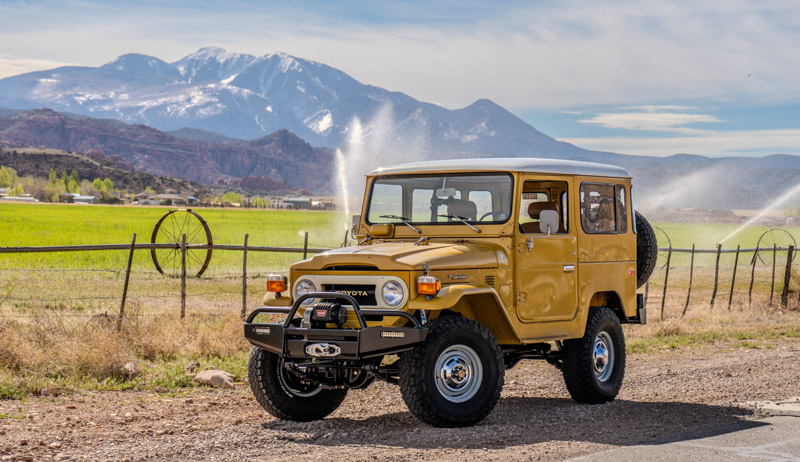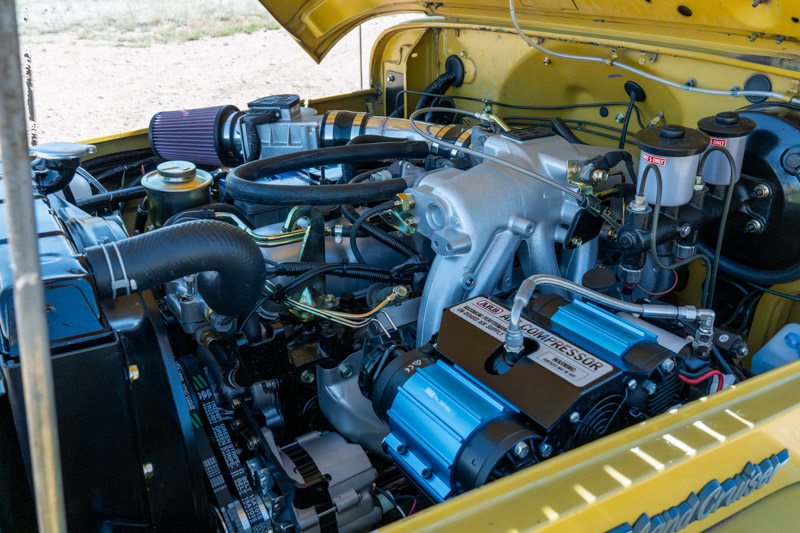Toyota 40 Series Restorations
At Proffitt’s Resurrection Land Cruisers, our tastefully designed and meticulously carried out restorations and custom resto-mods are world-renowned and second to none in quality and innovation. Each Land Cruiser is custom-built and tailored to its owner’s desires. Each restoration below is unique, and the careful observer will notice the quality and craftsmanship evident in every square inch of what we take so much pride in.
Completed Restorations
What FJ40 is Right For You?
We Know the 40 Series
I talk to a lot of people about 40 series Land Cruisers. It’s one of my favorite things to do. One of the things that a lot of people are surprised to learn about the 40 series is that even though the model’s looks barely changed from its introduction in the United States in 1962 to its final version in 1983, there were many significant differences. Understanding those differences is really important if you want to own and use one, and especially if you plan to restore or modify one.
In my head, I loosely classify all 40 series Land Cruisers into four groups, and I use those groups to counsel people about owning or building them in four uniquely different ways.
The first group is Really Early 40 Series. The model was in its infancy for the first two years of the 40 series, 1962 and 1963. Toyota was just figuring out what worked. These two years had a 1F engine and a unique transmission and transfer case configuration. The transmission was four-speed, and the transfer case was a single-speed unit with no low range. Additionally, the rear differential was located in the center of the rear axle, resulting in a strange, horizontal driveshaft angle from the output of the transfer case, which was on the right, back to the center of the rear axle. This obscure configuration would have likely resulted in significant drivetrain noise at high speeds. Fortunately, it probably wasn’t a problem. The early 1F engine, with a single barrel carburetor and the stout but off-road-oriented design of the entire vehicle, meant that people weren’t likely to drive it fast in the first place. Visually, these models had a very different looking corrugated hardtop, and a bifold rear window that significantly reduced rear visibility. They also lacked the iconic rounded corner windows on the hardtop. Another significant difference is the stamping of the words “Land Cruiser” in the top of the front bezel. This is my particular preferred evidence in the debate of whether or not the bezel had an “up or a down.” A good friend of mine, Kurt Williams, would argue that as Toyota has issued official marketing photographs with the bezel upside down, they may have intended it to be that way occasionally. To this, I say “bullsh@t” and that the upside-down bezel phenom is always the result of ignorance or a baffoon. (oh, that and if the bezel is upside down, the TOYOTA logo isn’t centered in the opening. Take that, Kurt!) These really early 40s are rare, and when they still exist in stock form, they should probably be kept that way. If you own or find one…no rock crawlers, engine swaps, or bad modifications, please.
The second group, as I think of it, is the Mid 60s to mid 70s FJ40. Despite some changes from 1964 to 1973, the model stayed fairly consistent in terms of practicality. Toyota went away from the centered rear differential and four-speed transmission, replacing it with a three-speed transmission and two-speed transfer case. They moved the rear differential to the right side, which matched the front differential’s location, resulting in both driveshafts being on the right side of the vehicle. A couple of changes were made to the 1F, but the engine’s basic design stayed with the 40 series throughout these years. Different shifter configurations were used, steering column “tree” and floor, and all 40s had a split bench seat across the front. They also had 4-wheel drum brakes, which, although improved greatly in 1970 with the addition of a dual circuit master cylinder, were still just that… drum brakes. The combination of these features made the FJ40 a little impractical to drive by today’s standards, both on and off-road. The 1F engine did not like to be revved high, and the lack of an overdrive meant that the vehicle was only capable of speeds around 55 miles an hour. You didn’t want to go faster than that anyway because the four-wheel drum brakes wouldn’t have been incredibly effective in stopping you. Additionally, the discomfort of sitting on a springy bench seat, slightly out of alignment with the steering wheel, would limit the amount of time most people would want to spend behind the wheel.
Don’t get me wrong, these models were still ahead of their time in the four-wheel-drive world. Comparing a 1970 FJ40 to a 1970 Jeep would be like comparing the space shuttle to one of those balsa wood airplanes you put together out of a package when you were a kid. The Toyota FJ40 Land Cruiser was already technically superior, and significant changes would come. This group of FJ40s, by the way, was also sold in the highest numbers in the US, making them far more common to come across today. This, plus the fact that they were less practical to drive, makes them the best candidates for modification, at least in my mind.
The third group of 40 series Land Cruisers started in 1975 and went through 1978. These Late 70s 40s are when Toyota began to really make some changes that made a difference in how practical the FJ40 was. 1975 saw most of these changes, but it wasn’t until 1976 that you could buy an FJ40 with everything needed to be a practical daily driver, even by today’s standards. 1976 FJ40 had a 2F engine and four-speed transmission with an even stronger transfer case. Toyota upgraded the front brakes to discs, which made stopping much more pleasurable. The model also sported bucket seats, (introduced in 1973), and a factory roll bar. The door configuration was also different, with the driver and passenger doors being of a one-piece design that incorporated a door panel that cut down on road noise. The rear doors were “ambulance style”, with a full-length door that could be opened and closed from inside the vehicle. This allowed for easier rear passenger ingress and egress. Except for the change to disc brakes in 1976, 1975 through 1978 models were almost mechanically identical. A couple of minor cosmetic changes make identifying different years within this range doable. 1975 and 1976 FJ40s looked almost exactly the same, but the 76 had disc brakes in the front. 1976 and 1977 FJ 40s were visibly different because in 1977, Toyota added a small “kick out” rear window in the hardtop, which allowed for ventilation for the rear passengers. That top-side design stayed consistent through the rest of the 40 series. 1977 and 1978 FJ40s can be differentiated by one thing- the windshield squirter. In 1977, the windshield squirter was located in the hood, and in 1978, it moved to the top of the windshield frame. This is the only exterior difference between the two years. This group of 40 series Land Cruiser was very practical to use, making “keeping the Toyota DNA” a real consideration when owning one.
The final group, The Late Model 40s, 1979 through 1984, is where the 40 series Land Cruiser reached maturity. There were a few more significant mechanical and cosmetic changes to the model throughout these years, but one easily identifiable difference was that in 1979, Toyota went to the more “squared” front headlight bezel. I personally have grown to love the newer square bezel, but many Land Cruiser enthusiasts still frown when they see the variance from the iconic rounded bezel that Toyota used for almost 20 years. The bezel, however, was just the tip of the iceberg. You can’t really tell from the outside (except for the shape of the fuel door opening), but Toyota had actually changed the design of the entire body tub. They moved the gas tank from inside the vehicle under the passenger seat, to underneath the vehicle. The frame and body mounts were changed to accommodate this new body. The new body shape also required different bucket seats than the previous years. Even though a 1978 and 1979 FJ40 were virtually mechanically identical and visually identical looking (with only the squared bezel separating the two), they were completely different animals. 1980 through 1983 saw more mechanical improvements, with the 1981 model getting a new transfer case, commonly called the split transfer case. It was a more robust unit and lacked driveline mounted parking brake provisions. Toyota moved the parking brake to the rear axle. Also, starting in 1981, factory power steering and air conditioning were options. These were “the glory years” of the FJ40 in terms of practicality and drivability. It’s really for that reason that I encourage people who own a late model FJ40 to keep it original, or at least mostly original, when they build/restore them.


